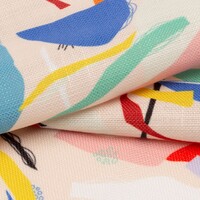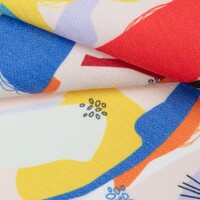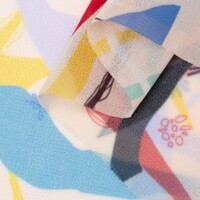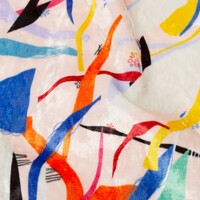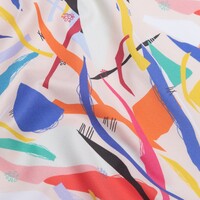Related:
Back to Site Stores ({{popupVm.storeTotalCount}})
Artists ({{popupVm.artistTotalCount}})
Upload your designs to create custom curtain fabric. Choose from a range of fabrics with different weights...
Read MoreShips In 1 - 2 days
Delivery: $12.95
Handmade
Creating custom curtain fabric is a walk in the park.
Choose from our wide range of curtain fabrics, from delicate lace to classic suede.
Soft, faux suede face with synthetic rubber back. Non fray, solid and strong. Fire rated & water repellent.
100% polyester
Lightweight woven poly-blend. Durable and solid with a slight spring. Soft, matte and opaque.
100% polyester
Stiff, non-fray, splash- proof woven poly. Delicate net texture with shiny face.
100% polyester
Silky, sheer and light. Soft woven poly. Semi-transparent with strong contrast print. Good natural drape.
100% polyester
Knitted poly fabric. Very stretchy, with a soft shimmery pile. Bright, intense colors. Retains heat well.
98% polyester, 2% elastane
Coarse, open weave linen look fabric. Thick mesh-like textured surface. Still soft to touch. Off-white cream base tone.
100% polyester
Distinguished herringbone weave. Soft, cotton-feel. Textured on both sides. Off-white base tone.
100% polyester
Luxury shimmery face with short pile and a stiff, coarse back. Durable, holds shape well. Sharp print quality.
100% polyester
Smooth and crisp surface with lustrous sheen. Good strength and slightly stiff. Shimmery finish.
100% polyester
Classic chenille fabric, soft and strong. Textured caterpillar pile. Retains heat, water absorbent.
100% polyester
100% silk, tight weave, light and airy. Crepe-like texture with a dry handle. Soft, saturated tones.
100% Silk
Expected Shrinkage = Weft: 6% Warp: 9%
100% cotton, satin weave. Soft and smooth with a matte finish. Drapes easily, sharp, detailed print.
100% cotton
100% silk, mesh-like open weave. Sheer, transparent, fluid and taut. Muted tones.
100% polyester
Sheer finish, very fine open weave. Shiny and semi transparent with natural, flowing drape.
100% polyester
Soft and dry with crepe textured face. Added strength from poly fibers. Natural drape, punchy detailed print.
100% polyester
Taut and strong dobby weave with solid drape. Slight sheen. Natural ochre base tone adds rustic charm.
face: 100% poly. backing: 65% poly, 35% cotton
100% Linen. Natural slub yarns, charming mottled surface texture. Breathable, light, slightly firm structure.
100% polyester
Short pile makes for a super soft fabric, scrim back, opaque with slight sheen.
100% polyester
70% cotton 30% silk lightweight woven voile. Print shows through 90% to reverse. Super bright colors & deep blacks using reactive ink chemistry.
70% cotton, 30% silk
Expected Shrinkage = Weft: 2% Warp: 1%
325 thread count, high quality bedding material. 100% BCI cotton (Better Cotton Initiative) . Bright white base color, smooth luxury delicate yet durable material. 5-Star hotel bed linen quality. Wide width material at up to 69" print width.
100% cotton
Expected Shrinkage = Weft: 1% Warp: 1%
Medium weight 100% linen plain weave fabric. Contains characteristic slubs and bobbles, will include occasional unprinted white dots. Super bright colors & deep blacks using reactive ink chemistry. Uses: clothing, kitchen textiles, curtains, light upholstery.
100% linen
Expected Shrinkage = Weft: 5.8% Warp: 1.6%
Care instructions
86°F wash, low tumble dry heat or hang to dry, do not wring.






Once we receive your order our technology starts the processing, printing and finishing of your curtain textile. We will dispatch it within 1 - 2 days.
We have many materials that can be used for curtains, but our Suede Vision textile is the most popular. This is brilliant for printing and sewing and feels great in the hand. It has a good body and an applied backer giving a luxury feel. If this material is used in conjunction with a thick interline and a strong lining, you will have a curtain textile fit for a palace. Due to the delicate nature of the MulMul Soft Music fabric, some pulls are to be expected this is not out of the ordinary.
Care: Our curtains materials can be machine washed without loss of
Your designs are printed onto the custom curtain fabric using up to date digital printing techniques. This bonds the eco-friendly inks deep into the fiber of the material creating a vivid, long-lasting print. This will not fade over time, peel or rub off. Once printed our craftsmen will make sure that your fabric is cut to the size you specified, and this will then either be passed to the seamstresses if you chose a hemming option or straight to quality control if you didn't. You have a choice of curtain fabric edge finishes which are as follows:
Important: please read our full guidelines on shrinkage and hemming. This is essential for when you measure up your material.
All of our fabrics are printed at 200dpi. This works for us as it combines a great quality as well as a good file weight. In order to avoid resizing and interpolation, we recommend that you scale your image to 100% at 200dpi. Our design interface works with a traffic light system that acts as a quality marker for your designs. This will show you whether the resolution is too low for printing. When you re-upload your design with a highest resolution, the traffic lights will change color, showing you're good to go. A message will pop up alongside the traffic lights to let you know if the resolution is too low or if you have a good quality image.
Your uploaded design will automatically be scaled to fit the size of fabric you've chosen. You can change the dimensions of your fabric by amending the measurements on the ‘Product Options’ tab, under ‘Print Size’. To see how this fits with the dimensions of your image/design, you can refer to the ‘Images & Text Tools’ tab under 'Quality Information'. Here, you will be able to edit the dimensions of the image.
We always recommend using an RGB color space when you upload your images. More specifically, we suggest using the sRGB image profile, to achieve best color results. This will need to be done in your editing software; choose RGB as the working space, and assign the image profile as sRGB (full name sRGB IEC61966-2.1)
There is no length limit for most of our fabrics. Our preview design window is set up to displaying a maximum of 10m (32.8 ft) to help you visualize the print, but that doesn't mean this is the print limit. If you'd like to order more, you can increase the quantity (x2 for 20m or x4 for 40m for example) and order as much as you'd like. Larger volumes will receive an automatic discount too. While the fabric length is nothing to worry about, each individual fabric will have a maximum width side: These can be found on the fabric's page information or in the design interface.
Yes, that will help you when it comes to cutting or framing your printed fabric. We recommend always adding a little extra space for borders into your purchased fabric size. When we print your materials, or send out fabric samples, we typically trim squarely around the fabric, leaving approximately 5mm white space. Cutting neatly on the line has an additional fee.
Crocking is the term used to describe fading along the creases in a fabric. It typically can occur after constant washing or heavy use of digitally printed natural fabrics. Crocking can be minimized by hand washing your fabrics at a cooler temperature, rather than machine washing. If you want to make sure there's no chance of crocking, we'd suggest you use a poly fabric.
Yes, our organic fabrics don't have an additional coating like non-organic fabrics have, which means it absorbs the inks deep into its fiber and reducing the color strength slightly (this can be approximately -40%). If you would like a bolder, more vibrant color for your fabric, we would suggest using a non-organic fabric.
Unfortunately not; all of our fabrics have been tested meticulously to ensure we know exactly how to get the best results, and our facilities cater perfectly to them. If you are set on a fabric we don't offer, we can offer custom printed sublimation paper to order which will allow you to heat press your designs onto your own fabrics.
If your design is simple and less intricate, a JPEG will be absolutely fine. However, if you have created a design with multi-colored detailing, we would recommend saving your design in a TIFF format.
Similar to other fabric printing processes, shrinkage can occur. The amount of shrinkage will depend on the fabric, but as a general rule of thumb, please allow for 2-8% shrinkage when working out your measurements. Shrinkage is not an exact science, and the amount of shrinkage will vary from print run to print run. We'd always suggest order a little more than you need for your project.
Many of the fabrics we offer are semi-transparent, so printing on both sides of the fabric is not a service we offer.
At the moment, all of our fabric labels are printed on satin fabric. For now, we believe this is the best choice, but will potentially introduce other options in the future. All labels are cut to the same label format. If you would like to choose a different fabric and format for your labels, you could always order a sheet of the fabric of your choice to create labels yourself.
Our fabrics are printed with water-based inks as environmental consciousness is always front of our minds. Water-based inks include no chemicals or solvents, and our printing process uses heat to fix colors and patterns into place to avoid excess or contaminated water returning into the water system (this is something that can occur through steaming). All printing, fulfilment and production is done in our one facility, and rather than rolling the fabrics or sending them in a tube, you will receive your material folded up. This amounts to 150 tubes saved a week, as well as much more space on the delivery van for more orders. (For delicate fabrics we ensure to package appropriately).
Although very rare, there could be a slight color difference from one print run to another. This is a normal part of the printing process, however we are always working to improve our color profiles. It is unlikely that the difference in print runs will be hugely different (for example, it's unlikely your orange is suddenly going to be red). The likelihood of color variations can be intensified fabric to fabric due to materials having different grains and textures; natural fabrics typically have more muted color tones, while poly alternatives have a bolder hue. This is because the construction of the material is different, and the printing method has to be altered slightly for more delicate, natural textiles.
Our full cut & sew service at Bags of Love can be used to your full advantage. We even offer hemming for your fabrics at a small additional cost. Our hems are created with a one or two cold hem that typically uses around 5 to 20mm of fabric (depending on the thickness of your chosen material). Please bare this in mind when you are ordering your printed fabric with hems: If you would like your finished piece to be 40" x 40", change your dimensions to 41" instead to allow space for your hems (you will also need to include additional for potential shrinkage). The thicker the fabric, the bigger the hem will be. Your printed fabric will be hemmed with either Black or White thread. If you are ordering a lightly woven material or a printed silk, you will find that one hem will be straight, while the other slightly rippled. The hemming material allowances are as follows and you need to make your print bigger to accommodate the hem:
For further information about our fabrics see our FAQs.
Please note: As everything we provide is handmade to order, you may find a slight variance in the sizes.





